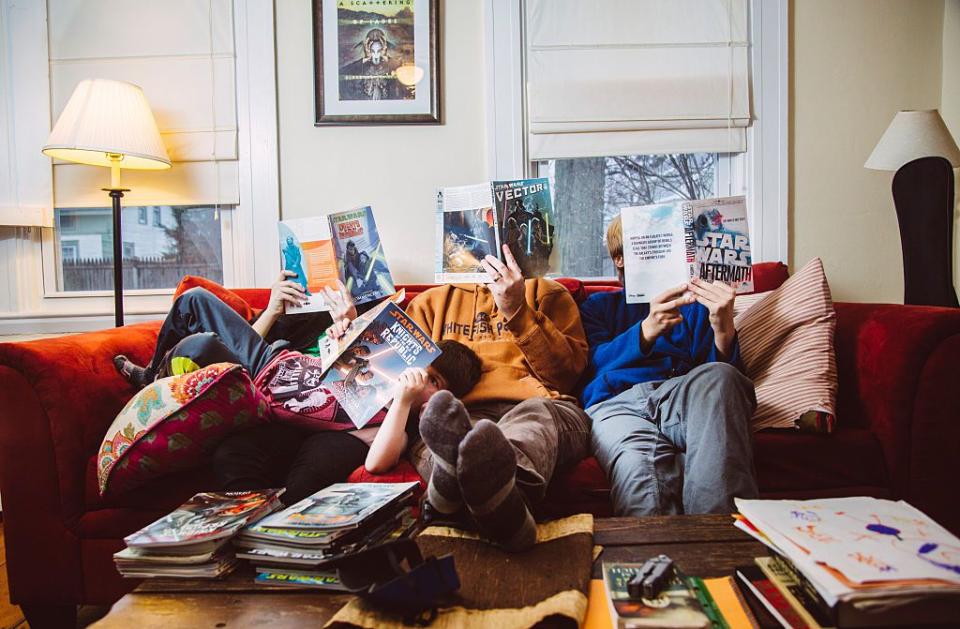Let Your Child Read Graphic Novels
When you're raising a reader, every word counts. Graphic novels are a great way to get your child into reading, and parents should let kids read what they want.

Portland Press Herald | Getty Images
At dinner with a new family we'd met through sports, our conversation turned tense when the father shared his views on graphic novels.
His face scrunched as he said, "They're not very challenging. I think our kids should read real books."
He didn't know that he was talking to a graphic novelist. Awkwardly, I shared my profession. My husband laughed, my 7-year-old daughter chimed in about her favorite graphic novels. I followed up with various points to contradict him. This conversation was agonizingly familiar. The sentiment that graphic novels are the underclass of literature is far too common.
Which begs the question, if they're not "real" books, what exactly are graphic novels made of? Dream fiber? Cat hair? Space goo? Anyway. Whether it's parents or teachers or librarians, the disdain vocalized is for a medium that our kids love. The medium that's my life's work.
Adults know that kids love graphic novels. But many parents and educators want to discourage kids from reading them. Read that again. Adults want to discourage kids from reading. Why?
Adults know that kids love graphic novels. But many parents and educators want to discourage kids from reading them. Read that again. Adults want to discourage kids from reading. Why? There's an incorrect assumption that graphic novels don't challenge readers and lack the necessary components to build literacy. Graphic novels introduce more complex words at a younger age than traditional novels because the illustrations aid in kids comprehending the words. The complexity within graphic novels asks the reader to decode both the words and images, and readers utilize inference and synthesis to engage more of their brain. Multiple studies have shown that pairing words and pictures increases comprehension from 50 to 120% over text alone.
Graphic novels provide multimodal learning. They build vocabulary, comprehension, and critical thinking. A study done by the University of Oregon Center on Teaching and Learning found that comics averaged 53.5 rare words per 1000, which was more than adult books, picture books, or the conversations of college graduates. Most graphic novel readers will branch out to prose novels. Some may not but that's OK. If the point is to help our kids read, then we should let them read what they want. Allowing your child to select their own reading material is the most important factor to raising a reader.
Related:
Even though I know this fact, I want to steer my daughter away from books below her reading level. I remember and stop myself. She wanted to read Pizza My Heart, by Mika Song, because it's part of a series and she loved the main characters. I know it's too easy for her. Does that matter? If she wants to read, why should I stand in the way? She read it and then immediately re-read the previous books in the series. If I indulged my pesky need to judge her reading choices, she wouldn't have spent hours reading.
Graphic novels are great motivators. Kids are motivated to read! Ask any librarian (especially the naysayers) and they can't deny that the most circulated books are graphic novels. In a time when kids have games, iPads and TikTok at their fingertips, graphic novels are attractive and sought after. Books! If the goal is reading, then the path forward seems quite easy. Let them read graphic novels!
There's a misconception that if the activity is pleasurable that it isn't educational. My daughter excitedly read Tales of a Seventh-Grade Lizard Boy, a graphic novel by Jonathan Hill. She was excited because of the hook that the boy is secretly a lizard. The wraparound cover shows a human boy on the front and a lizard boy on the back. Intrigued, we read it together and she asked me questions about identity, bullying, and immigration. And we laughed out loud at parts. These books are high quality, sophisticated, and pleasurable. It seems like the most ideal combination. What more can we ask for from books?

Nidhi Chanani / Penguin Random House
Yes, I'm a graphic novelist. My bias is clear. Perhaps that will taint the facts that I present. I don't want to be armed with data at dinner with a new family. I don't want to argue the validity of my work. But the perception that graphic novels are not real books persists. So I continue to build my rebuttals. I gather information about graphic novels' positive impact on language development, comprehension, and empathy. I'm proud to make books that kids love. Many years into this work, I know my job isn't just to make books. My job is also to make sure that our kids have a frictionless path to them.
Graphic novels raise readers. That's the point, right?
So please: let your kids read graphic novels.
Related:

